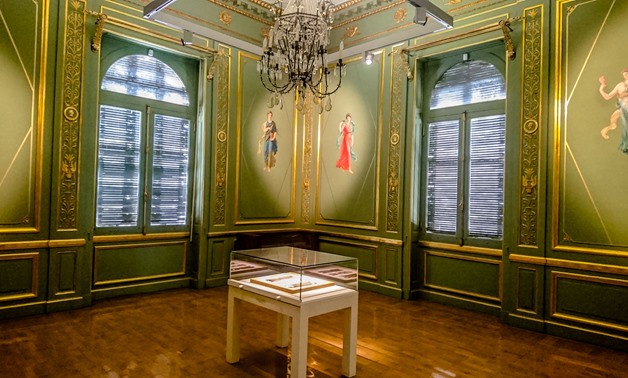
Sunlight reflecting on the paintings in Aisha Fahmy Museum. Picture taken April 7,2018 - Egypt Today/Mariam Mosleh
CAIRO – 14 April 2018: Princess Aisha Fahmy was the daughter of the Egyptian aristocrat and army chief of King Fuad I, Ali Fahmy. She was also the wife of Egyptian actor and director Youssef Wahbi. The Aisha Fahmy Palace was owned by her father and then given to her after her father passed away, although she bought her siblings shares in the palace. Wahbi lived with her in the palace for many years.
 View of the whole stair case and the paintings from the bottom. Photo taken April 7, 2018 - Egypt Today/Mariam Mosleh
View of the whole stair case and the paintings from the bottom. Photo taken April 7, 2018 - Egypt Today/Mariam Mosleh
Designed by Italian architect Antonio Lasciac in a beautiful, classic European style, the palace was built in 1907 by the Nile River in Zamalek on an area of 2,700 square meters.
 The garden of the palace. Photo taken April 7, 2018 - Egypt TodayMariam Mosleh
The garden of the palace. Photo taken April 7, 2018 - Egypt TodayMariam Mosleh
 One of the bedrooms in the Palace with its authentic European furniture. Photo Taken April 7, 2018 - Egypt Today/Mariam Mosleh
One of the bedrooms in the Palace with its authentic European furniture. Photo Taken April 7, 2018 - Egypt Today/Mariam Mosleh
The two-storey building contains five rooms with various original textile art and European oil paintings. A room originally used for playing billiards and a billiards scoring board was turned into a living room, where the name of Fahmy's father has been engraved in the wood. The furniture in the living room doesn’t belong to Fahmy, as the government and curators carefully chose the furniture to match the decorations in the room.
 Repainted door in one of Aisha Fahmy's rooms. Photo taken April 7, 2018 - Egypt Today/Mariam Mosleh
Repainted door in one of Aisha Fahmy's rooms. Photo taken April 7, 2018 - Egypt Today/Mariam Mosleh
 Living room in the Museum, used to an entertainment room with Billiards. Photo taken April 7, 2018 - Egypt Today/Mariam Mosleh
Living room in the Museum, used to an entertainment room with Billiards. Photo taken April 7, 2018 - Egypt Today/Mariam Mosleh
The second floor contains rooms for antiques, along with a Japanese room gifted to Fahmy by the Japanese embassy. The architecture of this room represents Japanese civilization and portrays two Buddha statues made of gold-plated wood.
 Original Turkish and Iranian carpets in Aisha Fahmy Palace. Photo taken April 7, 2018 - Egypt TodayMariam Molseh
Original Turkish and Iranian carpets in Aisha Fahmy Palace. Photo taken April 7, 2018 - Egypt TodayMariam Molseh
 Japanese designed room gifted from the Japanese Embassy to Aisha Fahmy. Photo taken April 7, 2018 - Egypt Today/Mariam Mosleh
Japanese designed room gifted from the Japanese Embassy to Aisha Fahmy. Photo taken April 7, 2018 - Egypt Today/Mariam Mosleh
The princess’s bedroom, meanwhile, was decorated with shiny gold leaves. She also had her own fitting room and a summer room next to the Japanese room. The aesthetic chandeliers in the museum and the artistic window paintings haven’t been changed since Fahmy’s time, although broken pieces of glass in the windows were restored and drawings were revived.
 Original Paintings on the windows by the stair case in the museum. Photo taken April 7, 2018 - Egypt TodayMariam Mosleh
Original Paintings on the windows by the stair case in the museum. Photo taken April 7, 2018 - Egypt TodayMariam Mosleh
 Different view of the Japanese room. Photo taken April 7, 2018 - Egypt Today/Mariam Mosleh
Different view of the Japanese room. Photo taken April 7, 2018 - Egypt Today/Mariam Mosleh
After Fahmy's death in 1962, the palace was given to the government. A decree was issued to make the palace a presidential mansion, before coming under the supervision of the Ministry of Culture. In 1975, Abdel Hameed Hamdy, chairman of the Arts and Literature Association, received an approval from then-Minister of Culture Yusuf Sibai to make the palace a part of the association. In the following year, the palace became the Center of Arts. Since then, the museum has held dear memories for almost all Egyptian artists who exhibited their work in the center.
 One of the original carpets owned by Aisha Fahmy. Photo taken April 7, 2018 - Egypt TodayMariam Mosleh
One of the original carpets owned by Aisha Fahmy. Photo taken April 7, 2018 - Egypt TodayMariam Mosleh











Comments
Leave a Comment